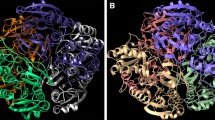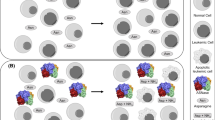Abstract
The enzyme Erwinia chrysanthemi l-asparaginase (ErA) is an important biopharmaceutical product used in the treatment of acute lymphoblastic leukaemia. Like all proteins, certain asparagine (Asn) residues of ErA are susceptible to deamidation to aspartic acid (Asp), which may be a concern with respect to enzyme activity and potentially to pharmaceutical efficacy. Recombinant ErA mutants containing Asn to Asp changes were expressed, purified and characterised. Two mutants with single deamidation sites (N41D and N281D) were found to have approximately the same specific activity (1,062 and 924 U/mg, respectively) as the wild-type (908 U/mg). However, a double mutant (N41D N281D) had an increased specific activity (1261 U/mg). The N41D mutation conferred a slight increase in the catalytic constant (k cat 657 s−1) when compared to the WT (k cat 565 s−1), which was further increased in the double mutant, with a k cat of 798 s−1. Structural analyses showed that the slight changes caused by point mutation of Asn41 to Asp may have reduced the number of hydrogen bonds in this α-helical part of the protein structure, resulting in subtle changes in enzyme turnover, both structurally and catalytically. The increased α-helical content observed with the N41D mutation by circular dichroism spectroscopy correlates with the difference in k cat, but not K m. The N281D mutation resulted in a lower glutaminase activity compared with WT and the N41D mutant, however the N281D mutation also imparted less stability to the enzyme at elevated temperatures. Taken as a whole, these data suggest that ErA deamidation at the Asn41 and Asn281 sites does not affect enzyme activity and should not be a concern during processing, storage or clinical use. The production of recombinant deamidated variants has proven an effective and powerful means of studying the effect of these changes and may be a useful strategy for other biopharmaceutical products.










Similar content being viewed by others
References
Beard, M. E. J., Crowther, D., Galton, D. A. G., Guyer, R. J., Fairley, G. H., Kay, H. E. M., et al. (1970). l-Asparaginase in treatment of acute leukaemia and lymphosarcoma. British Medical Journal, 1, 191–195.
Pieters, R., Hunger, S. P., Boos, J., Rizzari, C., Silverman, L., Baruchel, A., et al. (2011). l-Asparaginase treatment in acute lymphoblastic leukemia: A focus on Erwinia asparaginase. Cancer, 117(2), 238–249.
Vrooman, L. M., Supko, J. G., Neuberg, D. S., Asselin, B. L., Athale, U. H., Clavell, L., et al. (2010). Erwinia asparaginase after allergy to E. coli asparaginase in children with acute lymphoblastic leukemia. Pediatric Blood & Cancer, 54(2), 199–205.
Broome, J. D. (1968). Factors which may influence the effectiveness of l-asparaginases as tumor inhibitors. British Journal of Cancer, 22(3), 595–602.
Wriston, J. C. (1985). Asparaginase. Methods in Enzymology, 113, 608–618.
Aghaiypour, K., Wlodawer, A., & Lubkowski, J. (2001). Structural basis for the activity and substrate specificity of Erwinia chrysanthemi l-asparaginase. Biochemistry, 40, 5655–5664.
Lubkowski, J., Dauter, M., Aghaiypour, K., Wlodawer, A., & Dauter, Z. (2003). Atomic resolution structure of Erwinia chrysanthemi l-asparaginase. Acta Crystallographica Section D: Biological Crystallography, 59, 84–92.
Miller, M., Rao, J. K. M., Wlodawer, A., & Gribskov, M. R. (1993). A left-handed crossover involved in amidohydrolase catalysis: Crystal structure of Erwinia chrysanthemi l-asparaginase with bound l-aspartate. FEBS Journal, 328(3), 275–279.
Gervais, D., Allison, N., Jennings, A., Jones, S., & Marks, T. (2013). Validation of a thirty-year-old process for the manufacture of l-asparaginase from erwinia chrysanthemi. Bioprocess and Biosystems Engineering, 36(4), 453–460.
Aswad, D. W. (1995). Deamidation and isoaspartate formation in peptides and proteins. Boca Raton, FL: CRC Press.
Aswad, D. W., Paranandi, M. V., & Schurter, B. T. (2000). Isoaspartate in peptides and proteins: formation, significance and analysis. Journal of Pharmaceutical and Biomedical Analysis, 21, 1129–1136.
Gervais, D., O’Donnell, J., Sung, M., & Smith, S. (2013). Control of process-induced asparaginyl deamidation during manufacture of Erwinia chrysanthemi l-asparaginase. Process Biochemistry, 48(9), 1311–1316.
Zhang, T., Bourret, J., & Cano, T. (2011). Isolation and characterization of therapeutic antibody charge variants using cation exchange displacement chromatography. J Chromatography A, 1218(31), 5079–5086.
Khawli, L. A., Goswami, S., Hutchinson, R., Kwong, Z. W., Yang, J., Wang, X., et al. (2010). Charge variants in IgG1 isolation, characterization, in vitro binding properties and pharmacokinetics in rats. MAbs, 2(6), 613–624.
Laboureur, P., Langlois, C., Labrousse, M., Boudon, M., Emeraud, J., Samain, J. F., et al. (1971). l-Asparaginases from Escherichia coli. I. Properties of the native forms. Biochimie, 53, 1147–1156.
Laboureur, P., Langlois, C., Labrousse, M., Boudon, M., Emeraud, J., Samain, J. S., et al. (1971). l-Asparaginases d’Escherichia coli II: Plurality and origin of molecular forms: Relations with the biological activity. Biochimie, 53, 1157–1165.
Wagner, O., Irion, E., Arens, A., & Bauer, K. (1969). Partially deaminated l-asparaginase. Biochemical and Biophysical Research Communications, 37(3), 383–392.
Bae, N., Pollak, A., & Lubec, G. (2011). Proteins from Erwinia asparaginase Erwinase® and E. coli asparaginase 2 MEDAC® for treatment of human leukaemia, show a multitude of modifications for which the consequences are completely unclear. Electrophoresis, 32, 1824–1828.
Gupta, R., & Srivastava, O. P. (2004). Effect of deamidation of asparagine 146 on functional and structural properties of human lens αB-crystallin. Investigative Ophthalmology & Visual Science, 45(1), 206–214.
Takata, T., Oxford, J. T., Demeler, B., & Lampi, K. J. (2008). Deamidation destabilises and triggers aggregation of a lens protein, βA3-crystallin. Protein Science, 17, 1565–1575.
Minton, N. P., Bullman, H. M. S., Scawen, M. D., Atkinson, T., & Gilbert, H. J. (1986). Nucleotide sequence of the Erwinia chrysanthemi NCPPB 1066 l-asparaginase gene. Gene, 46, 25–35.
Sadler, J. R., Sasmor, H., & Betz, J. L. (1983). A perfectly symmetric lac operator binds the lac repressor very tightly. Proceedings of the National Academy of Sciences of the United States of America, 80(22), 6785–6789.
Oehler, S., Amouyal, M., Kolkhof, P., von Wilkcken-Bergmann, B., & Müller-Hill, B. (1994). Quality and position of the three lac operators of E. coli define efficiency of repression. EMBO Journal, 13(14), 3348–3355.
Gentz, R., & Bujard, H. (1985). Promoters recognised by Escherichia coli RNA polymerase selected by function: Highly efficient promoters from bacteriophage T5. Journal of Bacteriology, 164(1), 70–77.
Lanzer, M., & Bujard, H. (1988). Promoters largely determine the efficiency of repressor action. Proceedings of the National Academy of Sciences of the United States of America, 85(23), 8973–8977.
Kotzia, G. A., & Labrou, N. E. (2005). Cloning, expression and characterisation of Erwinia carotovora l-asparaginase. Journal of Biotechnology, 119, 309–323.
Lee, S. M., Wroble, M. H., & Ross, J. T. (1989). l-Asparaginase from Erwinia carotovora: An improved recovery and purification process using affinity chromatography. Applied Biochemistry and Biotechnology, 22(1), 1–11.
Lowry, O. H., Rosbrough, N. J., Farr, A. L., & Randall, R. J. (1951). Protein measurement with the folin phenol reagent. Journal of Biological Chemistry, 193, 265–275.
Harms, E., Wehner, A., Jennings, M. P., Pugh, K. J., Beacham, I. R., & Röhm, K. H. (1991). Construction of expression systems for Escherichia coli asparaginase II and two-step purification of the recombinant enzyme from periplasmic extracts. Protein Expression and Purification, 2, 144–150.
Papageorgiou, A. C., Posypanova, G. A., Andersson, C. S., Sokolov, N. N., & Krasotkina, J. (2008). Structural and functional insights into Erwinia carotovora l-asparaginase. FEBS Journal, 275, 4306–4316.
Whitmore, L., & Wallace, B. A. (2008). Protein Secondary structure analyses from circular dichroism spectroscopy: Methods and reference databases. Biopolymers, 89, 392–400.
Whitmore, L., & Wallace, B. A. (2004). DICHROWEB: An online server for protein secondary structure analyses from circular dichroism spectroscopic data. Nucleic Acids Research, 32, W668–W673.
Lobley, A., Whitmore, L., & Wallace, B. A. (2002). DICHROWEB: An interactive website for the analysis of protein secondary structure from circular dichroism spectra. Bioinformatics, 18, 211–212.
Sievers, F., Wilm, A., Dineen, D., Gibson, T. J., Karplus, K., Li, W., et al. (2011). Fast, scalable generation of high-quality protein multiple sequence alignments using Clustal Omega. Molecular Systems Biology, 7, 539.
Gouet, P., Robert, X., & Courcelle, E. (2003). ESPript/ENDscript: Extracting and rendering sequence and 3D information from atomic structures of proteins. Nucleic Acids Research, 31(13), 3320–3323.
Pettersen, E. F., Goddard, T. D., Huang, C. C., Couch, G. S., Greenblatt, D. M., Meng, E. C., et al. (2004). UCSF Chimera—A visualization system for exploratory research and analysis. Journal of Computational Chemistry, 25(13), 1605–1612.
Buck, P. W., Elsworth, R., Miller, G. A., Sargeant, K., Stanley, J. L., & Wade, H. E. (1971). The batch production of l-asparaginase from Erwinia carotovora. Journal of General Microbiology, 65, i.
Tyler-Cross, R., & Schirch, V. (1991). Effects of amino acid sequence, buffer, and ionic strength on the rate and mechanism of deamidation of asparagine residues in small peptides. Journal of Biological Chemistry, 266(33), 22549–22556.
Xie, M., & Schowen, R. L. (1999). Secondary structure and protein deamidation. Journal of Pharmaceutical Sciences, 88(1), 8–13.
Patel, K., & Borchardt, R. T. (1990). Chemical pathways of peptide degradation. II. Kinetics of deamidation of an asparaginyl residue in a model hexapeptide. Pharmaceutical Research, 7, 703–711.
Lascu, I., Chaffotte, A., Limbourg-Bouchon, B., & Veron, M. (1992). A Pro/Ser substitution in nucleoside diphosphate kinase of Drosophila melanogaster (mutation killer of prune) affects stability but not catalytic efficiency of the enzyme. Journal of Biological Chemistry, 267, 12775–12781.
Ashrafi, H., Amini, M., Mohammadi-Samani, S., Ghasemi, Y., Azadi, A., Tabandeh, M. R., et al. (2013). Nanostructure l-asparaginase-fatty acid bioconjugate: Synthesis, preformulation study and biological assessment. International Journal of Biological Macromolecules, 62, 180–187.
Jameel, F., Bogner, R., Mauri, F., & Kalonia, D. (1997). Investigation of physicochemical changes to l-asparaginase during freeze-thaw cycling. Journal of Pharmacy and Pharmacology, 49, 472–477.
Mills, J. E., & Dean, P. M. (1996). Three-dimensional hydrogen-bond geometry and probability information from a crystal survey. Journal of Computer-Aided Molecular Design, 10(6), 607–622.
Dunbrack, R. L. (2002). Rotamer libraries in the 21st century. Current Opinion in Structural Biology, 12(4), 431–440.
Krasotkina, J., Borisova, A. A., Gervaziev, Y. V., & Sokolov, N. N. (2004). One-step purification and kinetic properties of the recombinant l-asparaginase from Erwinia carotovora. Biotechnology and Applied Biochemistry, 39, 215–221.
Labrou, N. E., Papageorgiou, A. C., & Avramis, V. I. (2010). Structure–function relationships and clinical applications of l-asparaginases. Current Medicinal Chemistry, 17, 2183–2195.
Zhang, Y. (2008). I-TASSER server for protein 3D structure prediction. BMC Bioinformatics, 9, 40.
Roy, A., Kucukural, A., & Zhang, Y. (2010). I-TASSER: A unified platform for automated protein structure and function prediction. Nature Protocols, 5, 725–738.
Roy, A., Yang, J., & Zhang, Y. (2012). COFACTOR: An accurate comparative algorithm for structure-based protein function annotation. Nucleic Acids Research, 40, W471–W477.
Dehouck, Y., Kwasigroch, J. M., Rooman, M., & Gilis, D. (2013). BeAtMuSiC: Prediction of changes in protein–protein binding affinity on mutations. Nucleic Acids Research, 41, W333–W339.
Masso, M., & Vaisman, I. I. (2011) A structure-based computational mutagenesis elucidates the spectrum of stability-activity relationships in proteins. In: Proceedings of 33rd IEEE EMBC (pp. 3225–3228).
Masso, M., & Vaisman, I. I. (2011) Structure-based prediction of protein activity changes: Assessing the impact of single residue replacements. In: Proceedings of 33rd IEEE EMBC (pp. 3221–3224).
Masso, M., & Vaisman, I. I. (2010). AUTO-MUTE: Web-based tools for predicting stability changes in proteins due to single amino acid replacements. Protein Engineering, Design & Selection, 23, 683–687.
Kotzia, G. A., & Labrou, N. E. (2013). Structural and functional role of Gly281 in l-asparaginase from Erwinia carotovora. Protein & Peptide Letters, 20, 1302–1307.
Acknowledgments
The authors would like to thank Roger Hinton, Head of Development & Production, for facilitating these studies, Nigel Allison for advice and critical review of the manuscript, and Trevor Marks, Patrick Kanda, Richard Hesp and Michael Maynard-Smith for helpful discussions. Further thanks go to the entire Development & Production team at PHE Porton.
Author information
Authors and Affiliations
Corresponding author
Rights and permissions
About this article
Cite this article
Gervais, D., Foote, N. Recombinant Deamidated Mutants of Erwinia chrysanthemi l-Asparaginase Have Similar or Increased Activity Compared to Wild-Type Enzyme. Mol Biotechnol 56, 865–877 (2014). https://doi.org/10.1007/s12033-014-9766-9
Published:
Issue Date:
DOI: https://doi.org/10.1007/s12033-014-9766-9




